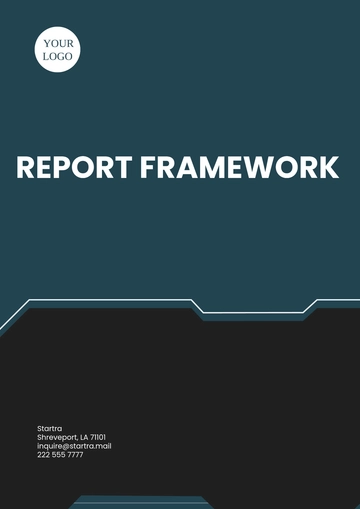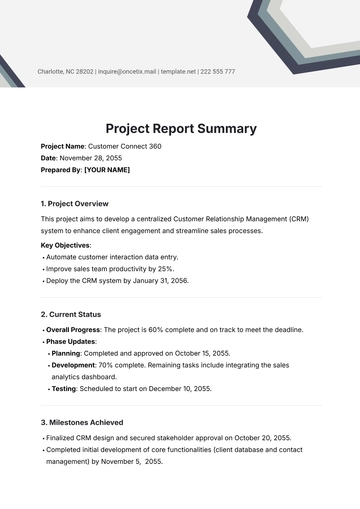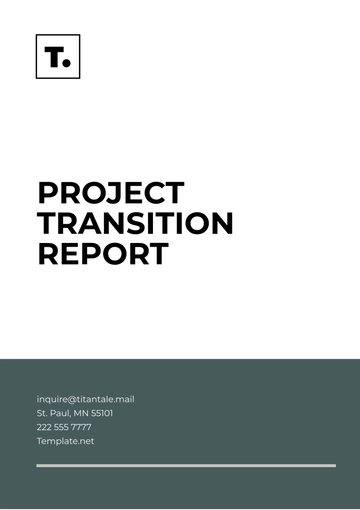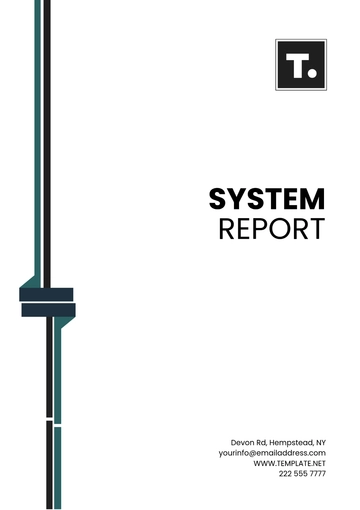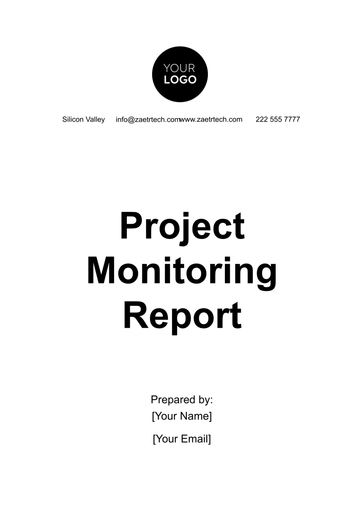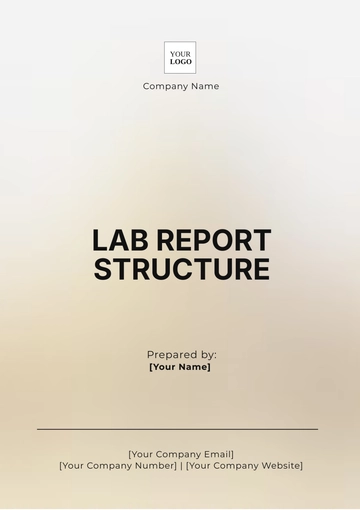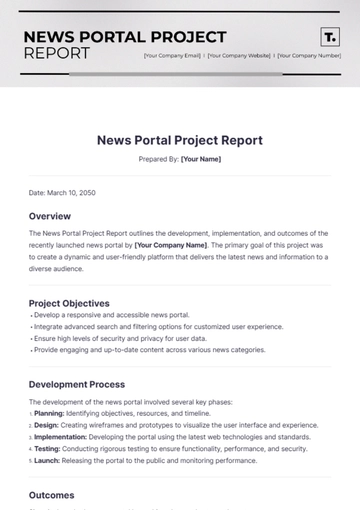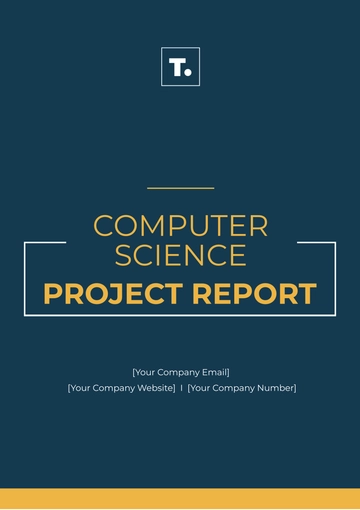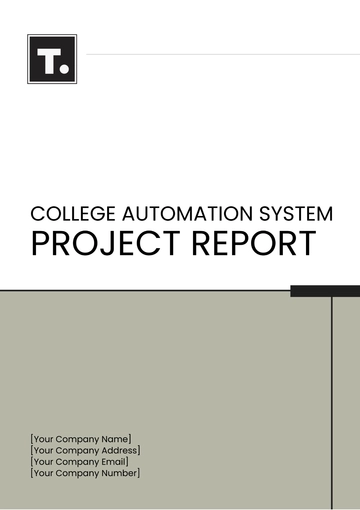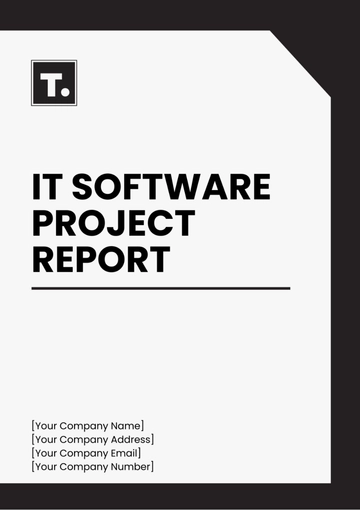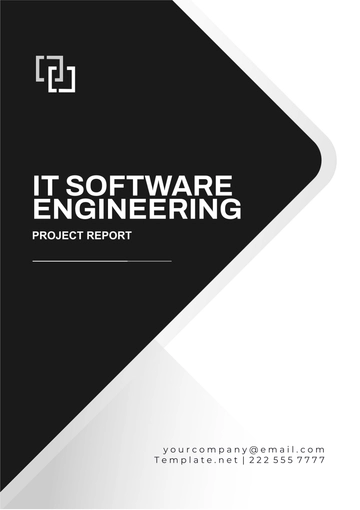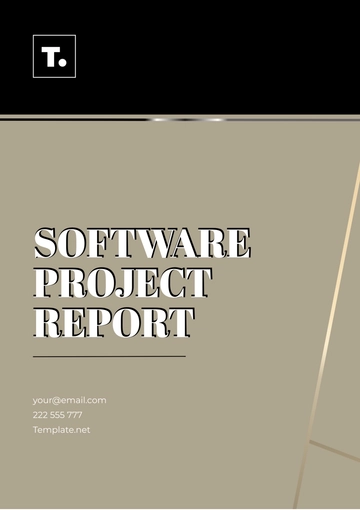Free Operations Project Performance Report

I. Executive Summary
Key Metrics | Performance |
|---|---|
Budget Performance | [$550,000] spent out of [$600,000] allocated |
Schedule Performance | [95%] of milestones completed on time |
Quality Performance | Identified and resolved [60] defects |
Stakeholder Satisfaction | Average satisfaction rating of [4.7/5] based on stakeholder feedback |
The project has maintained a strong performance throughout its duration, with [$550,000] of the allocated [$600,000] budget utilized effectively. Schedule adherence has been exceptional, with [95%] of milestones completed on time, contributing to timely project delivery. Quality management efforts have led to the identification and resolution of [60] defects, ensuring a high standard of deliverables. Stakeholder satisfaction remains high, with an average rating of [4.7/5] based on feedback received.
II. Introduction
The project, titled "Upgrade and Migration of Legacy System," commenced on [January 1, 20250], with the primary goal of enhancing system efficiency and scalability to meet evolving business needs. This initiative was critical to [Your Company Name]'s strategic objectives, aiming to streamline operations and improve overall productivity.
Led by [Your Name], the project team comprised cross-functional members from IT, operations, and finance departments. Key stakeholders, including department heads and end-users, were actively engaged throughout the project lifecycle to ensure alignment with organizational goals and requirements.
Throughout the report, key performance indicators (KPIs) such as budget utilization, schedule adherence, and quality of deliverables will be analyzed to evaluate the project's overall success and identify areas for improvement. Additionally, insights gained from stakeholder feedback and lessons learned will inform future project strategies and initiatives.
III. Project Overview
Project Details | Description |
|---|---|
Project Name: | Upgrade and Migration of Legacy System |
Project Duration: | [January 1, 2050], to [December 31, 2050] |
Project Manager: | [Your Name] |
Stakeholders: | IT Department, Operations Department, Finance Department |
The project, "Upgrade and Migration of Legacy System," aimed to modernize our existing legacy system to enhance operational efficiency and scalability. The project spanned from [January 1, 2050], to [December 31, 2050], with John Smith leading the project management efforts.
The project team collaborated closely with stakeholders from various departments, including the IT, Operations, and Finance departments, to ensure alignment with organizational objectives and requirements.
IV. Key Performance Indicators (KPIs)
KPI | Measurement |
|---|---|
Budget Performance | Total expenditure vs. allocated budget |
Schedule Performance | Percentage of milestones completed on time |
Quality Performance | Number of defects identified and resolved |
Stakeholder Satisfaction | Average satisfaction rating based on stakeholder feedback |
Throughout the project lifecycle, several key performance indicators (KPIs) were monitored to assess project progress and success. These KPIs provided insights into budget utilization, schedule adherence, quality of deliverables, and stakeholder satisfaction.
V. Project Summary
Status | Completion | Budget Usage | KPI Achievement |
|---|---|---|---|
In Progress | [85%] | [$550,000] | [95%] |
The project is currently in progress, with [85%] completion achieved thus far. The team has made substantial progress in executing project tasks and deliverables, aligning with the project timeline and objectives. However, [15%] of the project remains to be completed, with ongoing efforts focused on finalizing remaining tasks and ensuring successful project closure.
Budget usage stands at [$550,000], representing efficient utilization of allocated funds. The project team has diligently managed project expenditures, ensuring that resources are allocated judiciously to support project activities and deliverables. Despite potential budgetary constraints, the project remains on track to meet its financial objectives.
Key performance indicators (KPIs) have been achieved at a rate of [95%], indicating strong progress and adherence to project goals and objectives. These KPIs encompass various aspects of project performance, including schedule adherence, quality of deliverables, stakeholder satisfaction, and budget utilization. The high achievement rate demonstrates the project team's commitment to delivering results and meeting stakeholder expectations.
VI. Achievements
We highlighted the major accomplishments of the project, including milestones achieved, deliverables completed, and any notable successes.
A. Achievements
Successful completion of system requirements gathering
Design and development of new system modules
Completion of system testing and validation
Successful migration of data from legacy system
User training and adoption of new system
Throughout the project, significant achievements were realized, contributing to the successful execution of the Upgrade and Migration of Legacy System project. These achievements include the successful completion of system requirements gathering, design, and development of new system modules, thorough testing and validation of system functionalities, seamless migration of data from the legacy system to the new environment, and effective user training and adoption of the new system.
Moreover, the project team successfully adhered to the project schedule and budget, ensuring timely delivery of project milestones and efficient utilization of resources. Stakeholder engagement and communication were also key achievements, with regular updates provided to stakeholders to ensure alignment with project objectives and expectations.
VII. Challenges
Challenges | Strategies Implemented | Lessons Learned |
|---|---|---|
Legacy system complexities | Engaged subject matter experts for guidance | Importance of thorough system analysis |
Resource constraints | Prioritized tasks and reallocated resources | Need for flexible resource management |
Integration issues with existing systems | Conducted thorough testing and debugging |
|
Despite the project's successes, several challenges were encountered during its execution.
Legacy system complexities: The intricacies of the legacy system posed challenges during the migration process. To address this, the project team engaged subject matter experts to provide guidance and insights into navigating the complexities effectively. This experience underscored the importance of conducting thorough system analysis and understanding the intricacies of existing systems before embarking on migration projects.
Resource constraints: Limited availability of resources, both human and material, presented challenges throughout the project. To mitigate these constraints, the team prioritized tasks based on criticality, reallocated resources as needed, and optimized resource utilization to ensure the timely completion of project deliverables. This highlighted the need for flexible resource management strategies to adapt to changing project dynamics and resource availability.
Integration issues with existing systems: Integrating the new system with existing systems posed compatibility challenges, leading to integration issues and system disruptions. To address this, the team conducted thorough testing and debugging activities to identify and resolve integration issues promptly. This emphasized the importance of compatibility testing and ensuring seamless integration with existing systems to minimize disruptions and ensure system reliability.
VIII. Lessons Learned
We outlined the key takeaways from the project, including best practices identified, areas for improvement, and recommendations for future projects.
A. Lessons Learned
Importance of thorough stakeholder communication
Need for early identification of resource constraints
Value of regular project monitoring and reporting
The project provided valuable insights and lessons learned that can inform future project management practices and strategies.
Importance of thorough stakeholder communication: Clear and consistent communication with stakeholders proved to be critical for project success. Regular updates, status reports, and stakeholder meetings helped maintain alignment with project objectives, manage expectations, and address concerns promptly. Moving forward, prioritizing stakeholder communication and engagement from project initiation to closure is essential to ensure buy-in and support throughout the project lifecycle.
Need for early identification of resource constraints: The project encountered challenges related to resource constraints, including limited availability of skilled personnel and budget constraints. Early identification of resource constraints is crucial for effective resource planning and allocation. Proactive measures, such as conducting resource assessments, identifying skill gaps, and securing necessary resources early in the project lifecycle, can help mitigate these challenges and ensure smooth project execution.
Value of regular project monitoring and reporting: Regular project monitoring and reporting play a vital role in identifying project progress, identifying potential issues, and facilitating timely decision-making. Establishing robust project monitoring mechanisms, such as progress tracking, milestone reviews, and performance metrics analysis, enables project managers to proactively identify deviations from the project plan and take corrective actions as needed. Moving forward, maintaining regular project monitoring and reporting practices will enhance project transparency, accountability, and overall project success.
IX. Risk Management
We provided an overview of the project's risk management process, including identification of potential risks, mitigation strategies implemented, and the impact of risks on project performance.
Risk Mitigation Strategy | Impact on Project |
|---|---|
Technical challenges | Engage subject matter experts for guidance and support Minimal impact |
Resource constraints | Prioritize tasks and reallocate resources as needed Moderate impact |
Integration issues | Conduct thorough testing and debugging activities Moderate impact |
Throughout the project lifecycle, various risks were identified and managed proactively to minimize their impact on project performance.
Technical challenges: Technical challenges, such as system compatibility issues and software bugs, were mitigated by engaging subject matter experts for guidance and support. Their expertise helped address technical issues promptly, ensuring minimal impact on project progress.
Resource constraints: Resource constraints, including limited availability of skilled personnel and budget constraints, were managed by prioritizing tasks, reallocating resources as needed, and optimizing resource utilization. While these constraints had a moderate impact on project timelines, proactive resource management strategies helped mitigate their overall impact on project delivery.
Integration issues: Integration issues with existing systems were managed through thorough testing and debugging activities. By conducting comprehensive integration testing and resolving issues proactively, the impact of integration issues on system reliability and performance was kept to a minimum.
X. Future Considerations
A. Future Considerations
Post-project review and lessons learned documentation
Regular system maintenance and updates
Exploration of additional system optimization opportunities
As the Upgrade and Migration of Legacy System project nears completion, several future considerations and recommendations emerge to ensure continued success and maximize the value of the project outcomes.
Post-project review and lessons learned documentation: Conducting a comprehensive post-project review is essential to capture lessons learned, identify areas of improvement, and document best practices. This review should involve key project stakeholders, including project team members, sponsors, and end-users, to gather feedback and insights on project execution. Documenting lessons learned and recommendations for future projects will enable continuous improvement and inform decision-making for similar initiatives in the future.
Regular system maintenance and updates: To ensure the long-term stability, security, and performance of the newly implemented system, regular maintenance and updates are necessary. Establishing a maintenance schedule and implementing routine system updates, patches, and upgrades will help address any emerging issues, vulnerabilities, or evolving business requirements. Proactive maintenance practices will minimize system downtime, enhance system reliability, and extend the system's lifecycle.
Exploration of additional system optimization opportunities: With the new system in place, there may be opportunities to further optimize system functionalities, processes, and workflows. Conducting a thorough analysis of system usage patterns, user feedback, and evolving business needs can uncover potential areas for optimization and enhancement. These may include streamlining processes, integrating additional functionalities, or leveraging emerging technologies to enhance system capabilities and drive operational efficiencies.
XI. Conclusion
The Upgrade and Migration of Legacy System project has been a significant undertaking for [Your Company Name], aiming to modernize our legacy system and enhance operational efficiency. Through meticulous planning, diligent execution, and effective stakeholder collaboration, the project has achieved its objectives within the allocated budget and timeline. Key achievements include the successful completion of system requirements gathering, design and development of new system modules, thorough testing and validation, seamless data migration, and user training and adoption.
While the project encountered challenges such as legacy system complexities and resource constraints, proactive risk management strategies and mitigation efforts minimized their impact on project progress. Valuable lessons learned, including the importance of stakeholder communication, early identification of resource constraints, and regular project monitoring, will inform future project management practices and strategies.
The Upgrade and Migration of Legacy System project sets a solid foundation for [Your Company Name] to leverage modern technologies, streamline operations, and drive business growth. Moving forward, continued maintenance, optimization, and innovation will be essential to sustain the benefits of the project and meet evolving business needs effectively.
- 100% Customizable, free editor
- Access 1 Million+ Templates, photo’s & graphics
- Download or share as a template
- Click and replace photos, graphics, text, backgrounds
- Resize, crop, AI write & more
- Access advanced editor
Maximize project efficiency with our Operations Project Performance Report Template from Template.net. This versatile tool is fully editable and customizable to suit your project requirements. With our intuitive Ai Editor Tool, you can effortlessly make changes and updates as needed. Keep stakeholders informed and track project progress effectively with this comprehensive reporting solution.
You may also like
- Sales Report
- Daily Report
- Project Report
- Business Report
- Weekly Report
- Incident Report
- Annual Report
- Report Layout
- Report Design
- Progress Report
- Marketing Report
- Company Report
- Monthly Report
- Audit Report
- Status Report
- School Report
- Reports Hr
- Management Report
- Project Status Report
- Handover Report
- Health And Safety Report
- Restaurant Report
- Construction Report
- Research Report
- Evaluation Report
- Investigation Report
- Employee Report
- Advertising Report
- Weekly Status Report
- Project Management Report
- Finance Report
- Service Report
- Technical Report
- Meeting Report
- Quarterly Report
- Inspection Report
- Medical Report
- Test Report
- Summary Report
- Inventory Report
- Valuation Report
- Operations Report
- Payroll Report
- Training Report
- Job Report
- Case Report
- Performance Report
- Board Report
- Internal Audit Report
- Student Report
- Monthly Management Report
- Small Business Report
- Accident Report
- Call Center Report
- Activity Report
- IT and Software Report
- Internship Report
- Visit Report
- Product Report
- Book Report
- Property Report
- Recruitment Report
- University Report
- Event Report
- SEO Report
- Conference Report
- Narrative Report
- Nursing Home Report
- Preschool Report
- Call Report
- Customer Report
- Employee Incident Report
- Accomplishment Report
- Social Media Report
- Work From Home Report
- Security Report
- Damage Report
- Quality Report
- Internal Report
- Nurse Report
- Real Estate Report
- Hotel Report
- Equipment Report
- Credit Report
- Field Report
- Non Profit Report
- Maintenance Report
- News Report
- Survey Report
- Executive Report
- Law Firm Report
- Advertising Agency Report
- Interior Design Report
- Travel Agency Report
- Stock Report
- Salon Report
- Bug Report
- Workplace Report
- Action Report
- Investor Report
- Cleaning Services Report
- Consulting Report
- Freelancer Report
- Site Visit Report
- Trip Report
- Classroom Observation Report
- Vehicle Report
- Final Report
- Software Report
